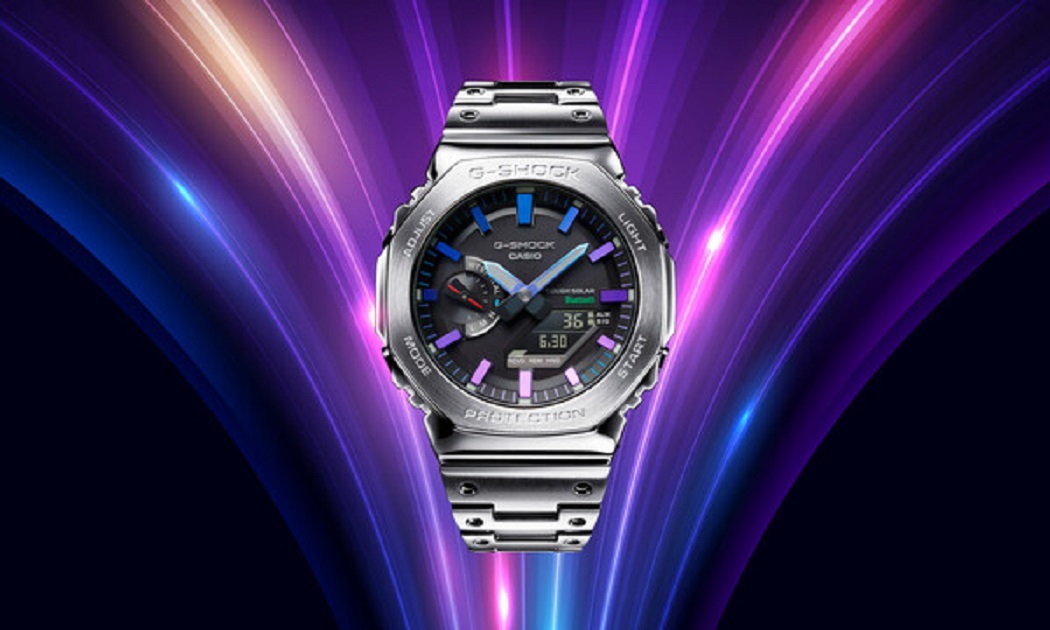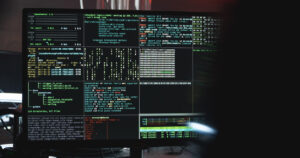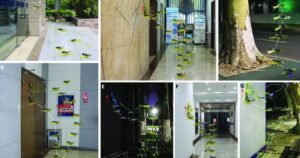
Presented the new polychromatic accents collection by G-Shock
DOVER, N.J., Oct. 25, 2023 /PRNewswire/ — Today, Casio America, Inc. is thrilled to introduce the Polychromatic Accents collection. This exceptional line of full metal timepieces pays homage to G-SHOCK’s time-honored legacy while embracing diversity and individuality

Prospects for the Moomoo Market: The Potential in Emerging US Technology Untapped, with Over 80% of Australian Investors Overlooking It
SYDNEY, Oct. 26, 2023 /PRNewswire/ — A significant portion of Australians are overlooking opportunities to grow their investment portfolios and gain exposure to booming overseas industries such as Artificial Intelligence (AI). According to

Fibocom Strengthens the 5G FWA Ecosystem at Broadband World Forum 2023
PARIS, Oct. 24, 2023 /PRNewswire/ — Fibocom (Stock Code: 300638), a global leading provider of IoT (Internet of Things) wireless solutions and wireless communication modules, took center stage at BBWF 2023 with its up-to-date

Invisible Danger: Your Essential Services Are Under Attack
In an increasingly interconnected world, the convenience and efficiency of essential services have become integral to our daily lives. From electricity and water supply to healthcare and transportation systems, these services form the backbone of modern society. However, there’s an invisible threat looming over them – the ever-growing risk of cyberattacks. As we rely more heavily on technology to deliver these services, the potential for disruption and chaos becomes a very real concern. It’s time to shed light on this looming danger and explore how cybersecurity companies are our safeguard against these threats. Essential services, once mostly reliant on manual operations, are now heavily digitized and interconnected. This connectivity offers unprecedented convenience and efficiency but also opens the door to malicious actors seeking to exploit vulnerabilities. Cyberattacks can disrupt power grids, compromise medical records, cripple transportation systems, and more. The recent surge in high-profile cyber incidents has demonstrated that no sector is immune, and the consequences can be devastating. Imagine a city suddenly plunged into darkness due to a cyberattack targeting its power grid. Hospitals struggle to maintain life-saving operations, transportation grinds to a halt, and communication systems falter. The interconnectedness of essential services amplifies the ripple effects of such attacks. Hospitals depend on electricity, which in turn relies on fuel distribution and communication networks. This domino effect showcases the intricate web of dependencies we often overlook. The battle against cyber threats is fought on many fronts, with cybersecurity companies at the forefront. These specialized firms dedicate themselves to staying one step ahead of cybercriminals. They develop sophisticated tools, strategies, and technologies to protect critical infrastructure and essential services from attacks. One of the key ways cybersecurity companies combat threats is through innovation. They develop advanced threat detection systems that can identify abnormal activities in real time, allowing for swift intervention. Machine learning and artificial intelligence play a crucial role in identifying patterns and anomalies that might otherwise go unnoticed. The battle against cyber threats is a collective effort. Governments, private sector entities, and cybersecurity firms collaborate to create a resilient defense. Sharing threat intelligence, conducting regular security assessments, and implementing best practices are vital to maintaining the integrity of essential services. In an ever-evolving digital landscape, it’s not a question of if but when the next cyberattack will occur. As essential services continue to rely on technology, the importance of cybersecurity cannot be overstated. Cybersecurity companies stand as sentinels, tirelessly working to thwart threats, protect our way of life, and ensure that essential services remain operational even in the face of malicious intent. In this ongoing battle between security and threat, the unseen heroes are the cybersecurity experts, dedicated to keeping our vital services up and running. As our dependence on technology grows, so too does the significance of their role, ensuring that the invisible danger remains just that – invisible – and that our essential services continue to serve and protect us.
Navigating the Future: How Aging Populations Shape Business Strategies
As the world experiences a demographic shift towards an aging population, the intersection of technology, healthcare, and wearables holds significant promise in enhancing the quality of life for seniors. With advancements in medical research and technological innovation, the potential to empower the elderly by addressing their unique needs and challenges has never been greater. In this article, we explore how the convergence of these domains is shaping a new era of healthcare, where wearables play a crucial role in fostering well-being, monitoring health, and promoting active aging. The global aging phenomenon presents both opportunities and challenges. Longer life expectancies bring with them a higher incidence of chronic diseases and age-related conditions. However, technology is emerging as a powerful ally in addressing these concerns. From smartphone apps that remind seniors to take their medications to wearable devices that track vital signs, technology is transforming how healthcare is delivered. Wearable technology, once associated primarily with fitness tracking, has evolved into an essential tool for healthcare monitoring and management. Smartwatches, fitness bands, and other wearables equipped with sensors can track heart rate, sleep patterns, activity levels, and more. For seniors, these devices offer a non-intrusive means of collecting vital health data, allowing them and their caregivers to proactively manage their well-being. One of the most significant benefits of wearables is the ability to remotely monitor patients. Healthcare providers can receive real-time data on a senior’s health metrics, enabling early intervention and personalized treatment plans. This technology is especially valuable for those with chronic conditions like diabetes, heart disease, and hypertension, as it reduces the need for frequent in-person visits and empowers individuals to take charge of their health. Wearables not only monitor health but also encourage seniors to stay active. Many devices offer features such as step counting, activity challenges, and guided exercises. These features promote physical activity, which is crucial for maintaining mobility, cognitive function, and overall well-being in older adults. Another challenge faced by aging populations is social isolation, which can lead to mental health issues. Technology plays a role here as well. Video conferencing platforms, social media, and messaging apps allow seniors to stay connected with loved ones and engage in virtual communities, mitigating feelings of loneliness and fostering a sense of belonging. Looking ahead, the integration of wearables with artificial intelligence (AI) and data analytics holds immense potential. AI-powered algorithms can analyze wearables’ data to detect subtle health changes and predict potential issues. This proactive approach to healthcare can prevent complications and hospitalizations, ultimately leading to improved quality of life for seniors. The amalgamation of aging, technology, healthcare, and wearables is reshaping the way we approach senior care. From promoting active aging to offering remote monitoring solutions, wearables are at the forefront of this transformation. As we navigate the challenges posed by an aging population, technology continues to provide innovative solutions that empower seniors to lead healthier, more independent lives. The future holds great promise, as we harness the power of technology to enhance the well-being of our older generations.

As Small As a Bug. The Robot That Can Land and Take Off
Insects that can perform a flapping-wing flight, climb on a wall, and switch smoothly between the 2 locomotion regimes provide us with excellent biomimetic models. However, very few biomimetic robots can perform complex locomotion tasks that combine the 2 abilities of climbing and flying. Here, we describe an aerial–wall amphibious robot that is self-contained for flying and climbing, and that can seamlessly move between the air and wall. It adopts a flapping/rotor hybrid power layout, which realizes not only efficient and controllable flight in the air but also attachment to, and climbing on, the vertical wall through a synergistic combination of the aerodynamic negative pressure adsorption of the rotor power and a climbing mechanism with bionic adhesion performance. On the basis of the attachment mechanism of insect foot pads, the prepared biomimetic adhesive materials of the robot can be applied to various types of wall surfaces to achieve stable climbing. The longitudinal axis layout design of the rotor dynamics and control strategy realize a unique cross-domain movement during the flying–climbing transition, which has important implications in understanding the takeoff and landing of insects. Moreover, it enables the robot to cross the air–wall boundary in 0.4 s (landing), and cross the wall–air boundary in 0.7 s (taking off). The aerial–wall amphibious robot expands the working space of traditional flying and climbing robots, which can pave the way for future robots that can perform autonomous visual monitoring, human search and rescue, and tracking tasks in complex air–wall environments. Insects possess remarkable flying and climbing abilities after millions of years of evolution. Their complex flapping flight and versatile posture adjustments enable them to achieve high lift, agile flight, and precise movements. Insects exhibit different adhesion mechanisms on various surfaces, using claws for rough surfaces and smooth pads for smoother ones. Wall-climbing and aerial robots have been developed to mimic these abilities, with wall-climbing robots using claws or adhesive pads, and aerial robots achieving flight with flapping-wing mechanisms. However, each type of robot has limitations in terms of energy consumption, load capacity, and interaction with the environment. Aerial–wall amphibious robots, combining both aerial and wall-climbing capabilities, offer a solution to overcome these limitations. These robots can transition between climbing and flying modes, enabling them to reach challenging areas and adapt to various environments. The development of such cross-medium robots is a significant step towards achieving insect-like maneuverability and stability for various applications. Discover the benefits and outcomes, along with additional in-depth information about this remarkable research, by clicking here. Source: qian li, haoze li, huan shen, yangguang yu, haoran he, xincheng feng, yi sun, zhiyuan mao, guangming chen, zongjun tian, lida shen, xiangming zheng , and aihong ji

U-Scan: The Automated In-home Digital Urine Analysis System by Withings
Sophisticated urine analysis allows users to monitor metabolic insights and empowers women to manage monthly cycles Withings is introducing the U-Scan, a miniaturized health lab that hygienically sits within a toilet bowl, unlocking health information in daily urine. Recognized as a CES 2023 Innovation Award honoree, U-Scan uses a pebble-shaped reader and changeable analysis cartridges to assess specific biomarkers without external sample capture or strips. The device will debut in Europe with two consumer health cartridges, with medical versions following in the future. The device is in development in the US and will not be available until FDA clearance. Withings Health Solutions is making the technology available for research purposes. U-Scan performs three tasks: Automated Sample Capture, which uses a rechargeable U-Scan reader within a toilet bowl, and Biomarker Analyses, which use a rotating cylindrical U-Scan cartridge with dozens of miniaturized test pods. The module system allows Withings to continually develop and support the analysis of biomarkers associated with various medical and health conditions. Combined with measurements from Withings’ ecosystem, U-Scan will create even more insights for users and potentially help prevent diseases, improve quality of life, and reduce healthcare costs. A game changer in home health, U-Scan is designed to be a versatile platform consisting of a technologically advanced pebble-shaped reader and changeable analysis cartridges designed to assess specific biomarkers without the need for external sample capture or strips. Then, with seamless sync to the Withings Health Mate app, it will provide a wealth of actionable insights based on daily readings. Withings is dedicated to creating a world where people can see their path to better health, and feel supported to pursue it using devices designed to fit beautifully into daily life, supported by information that unlocks long-term health insights and offers programs to create meaningful change. Withings has not provided a timeline for the US and the rest of the world release as of now. Find out more here.

Giving Voice to Deafness: The Unheard World of Oral Communicators
When envisioning a person with hearing loss, it’s common for the derogatory stereotype of a “deaf-mute” to come to mind – someone who doesn’t speak due to their inability to hear. This generalization, though far from accurate, has persisted for years, overshadowing the existence of deaf individuals who engage in oral communication. In reality, there are those within the deaf community who, despite their hearing loss, actively use spoken language to express themselves. Deaf individuals who speak, often referred to as “oralists” or “oral deaf,” navigate a multifaceted reality. Many of them have experienced hearing impairment since birth or lost their hearing at an early age. Through intense speech therapy and, in some cases, the support of auditory devices like hearing aids or cochlear implants, they have embraced spoken language as their primary mode of communication. Despite their ability to communicate orally, oralists often face unique challenges. Many people assume that all individuals with hearing loss use sign language, perpetuating a lack of awareness about their existence. As a result, oralists might encounter misjudgments and dismissals of their hearing impairment. These misconceptions can lead to frustration and feelings of invisibility. In the realm of education, oralists have distinct experiences. While some may attend mainstream schools, others opt for specialized programs that prioritize speech and auditory skills. Access to appropriate support services, such as interpreters or note-takers, becomes crucial in ensuring that oralists have equal educational opportunities. In the end, the world of deaf individuals who speak serves as a reminder that communication is a vast and nuanced landscape. It’s a testament to the human spirit’s adaptability, resilience, and determination to find a voice, regardless of the medium. By acknowledging the diverse ways in which individuals navigate the challenges of hearing impairment, we take a step toward a more inclusive and empathetic society. As my friend Alice Inácio from Portugal aptly puts it: “Oralized Deaf – We Exist, We Speak.” Blogger, writer, and communicator, Lak Lobato narrates her life experience as an oralized deaf individual and, since 2009, as a cochlear implant user. She employs her sensitivity brimming with poetry to discuss the (re)discovered sounds and aid in the advocacy of auditory technology users. Following the release of her first book, “Sorry, I Didn’t Hear!”

Powering the Future: Unveiling the Thrilling Era of Electric Propulsion Boat Pilot Academy
The UIM E1 Pilot Academy has been launched to prepare a new generation of racing stars for the upcoming world’s first electric propulsion boat championship. Among the 35 candidates, 20 pilots will be selected by October 2023 after undergoing initial training by September. The academy encourages athletes of all genders with experience in motorsport, cycling, Esports, extreme sports, and high-speed sports to apply. With the UIM E1 World Championship commencing in Jeddah, Saudi Arabia, in early 2024 and new teams being announced successively, the UIM E1 Pilot Academy is on the brink of its debut as the training pathway for a fresh cohort of racing luminaries. E1 is actively seeking athletes of all genders, experienced in motorsport, cycling, Esports, extreme sports, and high-speed activities, who are eager to test their mettle in the world’s foremost series of electric propulsion boat races. The new Academy is spearheaded by Nina Dreier, a seasoned professional who has previously collaborated with Red Bull, Formula E, and Extreme E, bringing her invaluable expertise in sports marketing and entertainment. Alongside receiving specialized training from other leading figures in the maritime industry, candidates will undergo an advanced training regimen meticulously designed to challenge their skills in close-quarter racing, across diverse vessels, and under varying water conditions. The selection process will unfold across Saudi Arabia, Italy, and the United Kingdom in August and September. The final 20 pilots chosen for the championship will be unveiled in October. Prospective athletes are strongly encouraged to apply for the initial phase of Pilot Training by emailing pilottraining@e1series.com, and including: – Name and surname – Nationality – Spoken languages – Gender – Practiced discipline – Resume or portfolio – Racing experience – Social media accounts or website – Availability (including other leagues for 2024) – Passport validity/eligibility to travel Once the selection process concludes, the UIM E1 World Championship teams and riders will make their debut in Jeddah, Saudi Arabia. Throughout 2024, they will compete in Venice, Munich, Rotterdam, and other locations to be announced shortly. The events of the UIM E1 World Championship will span two days, comprising practice sessions, qualifiers, and direct elimination races. Pilots will compete in several heats to determine who advances to the subsequent stage. The fastest teams and pilots will ultimately progress to the final race that will determine the champion. Engineers at SeaBird Technologies have successfully completed a rigorous testing program to optimize the performance and tuning of both prototype and production series RaceBird boats. There are 10 available spots on the E1 World Championship starting grid for teams, with RaceBird boats scheduled to be delivered by year-end. Each team will field two pilots, one male and one female, who will alternate in driving during the race weekend. The first season has already announced five teams led by NFL superstar Tom Brady, tennis legend Rafa Nadal, F1 icon Sergio Perez, former Chelsea star Didier Drogba, and team Venice Racing, with additional teams set to be unveiled in the upcoming weeks. To find out more about the E1 Series, visit the website.
